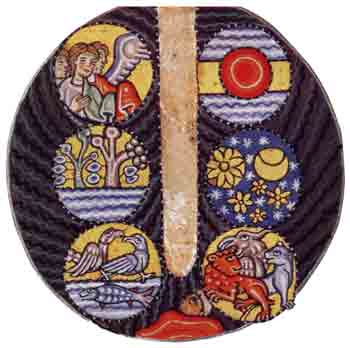Hildegard of Bingen
In my net travels, I came across a page that lists mystics ... Who's Who in the History of Western Mysticism by Professor Bruce B. Janz. One of the mystics listed was Hildegard of Bingen. Here's a bit about her ...
Hildegard of Bingen (1098-1179) is a particularly fine example of a German Medieval female intellectual and artist. She wrote The Divine Works of a Simple Man; The Meritorious Life; 65 hymns; a miracle play; and a long treatise of nine books on the different natures of trees, plants, animals, birds, fish, minerals, & metals. The Mother Superior, from early in life, claimed to have visions. When the Papacy supported these claims, her position as an important thinker was galvanized. The visions became part of one of her seminal works, Scivias (Know the Ways of the Lord), which consists of 35 visions relating and illustrating the history of salvation in 1142. The illustrations in the Scivias, as exemplified in the first illustration showing Hildegarde experiencing visions while seated in the monastery at Bingen, differ greatly from others created in Germany in the period. They are characterized by bright colors, emphasis on line, and simplified forms. While Hildegard likely did not pen the image, their idiosyncratic nature leads one to believe they were created under her close supervision.
- Women Artists - Wikipedia
And more about her music ...
Approximately eighty compositions survive, which is a far larger repertoire than almost any other medieval composer. Among her better known works is the Ordo Virtutum ("Order of the Virtues" or "Play of the Virtues"), a type of early oratorio for women's voices, with one male part - that of the Devil. Much of her music was created with an evangelical purpose to be performed not only by the nuns of her convent but also by male communities as evidenced by her gift to the Cistercian Abbey at Villers. The text of her compositions uses a form of modified medieval Latin unique to Hildegard, for which she created some invented, conflated and abridged words ...
- Hildegard of Bingen - Wikipedia
Below are some illustrations from Scivias (there are no officals titles for the illustrations) ...

- Self-portrait

- Cosmic Egg

- Creation

- detail

- Taming the Devil

- Light Stars, Dark Stars

- New Heaven, New Earth
Hildegard of Bingen (1098-1179) is a particularly fine example of a German Medieval female intellectual and artist. She wrote The Divine Works of a Simple Man; The Meritorious Life; 65 hymns; a miracle play; and a long treatise of nine books on the different natures of trees, plants, animals, birds, fish, minerals, & metals. The Mother Superior, from early in life, claimed to have visions. When the Papacy supported these claims, her position as an important thinker was galvanized. The visions became part of one of her seminal works, Scivias (Know the Ways of the Lord), which consists of 35 visions relating and illustrating the history of salvation in 1142. The illustrations in the Scivias, as exemplified in the first illustration showing Hildegarde experiencing visions while seated in the monastery at Bingen, differ greatly from others created in Germany in the period. They are characterized by bright colors, emphasis on line, and simplified forms. While Hildegard likely did not pen the image, their idiosyncratic nature leads one to believe they were created under her close supervision.
- Women Artists - Wikipedia
And more about her music ...
Approximately eighty compositions survive, which is a far larger repertoire than almost any other medieval composer. Among her better known works is the Ordo Virtutum ("Order of the Virtues" or "Play of the Virtues"), a type of early oratorio for women's voices, with one male part - that of the Devil. Much of her music was created with an evangelical purpose to be performed not only by the nuns of her convent but also by male communities as evidenced by her gift to the Cistercian Abbey at Villers. The text of her compositions uses a form of modified medieval Latin unique to Hildegard, for which she created some invented, conflated and abridged words ...
- Hildegard of Bingen - Wikipedia
Below are some illustrations from Scivias (there are no officals titles for the illustrations) ...

- Self-portrait

- Cosmic Egg

- Creation

- detail

- Taming the Devil

- Light Stars, Dark Stars

- New Heaven, New Earth


6 Comments:
Interesting artistry. I don't have the language to describe what I want to say, but it seems to me that she was way ahead of her time.
Hi Doug ... I'm going to miss you while you're on vacation :-)
Hey Crystal. I go away from my computer for a couple of days and you've got all these great posts!
Hildegard is very interesting and remarkably polyfaceted. Very original for a medieval artist, who generally rely heavily on tradition. You should get a listen to her music. There is a group called Sequencia that is recording all of her compositions and they catch the weird beauty of her work very well.
I read part of Scivias in the original with my Latin reading group. Very trippy.
Hi Liam, some of her art looks almost contemporary ... I'd love to hear her music - I'll look for it. trippy visions :-)
Here is a poem by Hildegard, "God's trumpet," I thought you might like:
Antiphon for Divine Wisdom
Sophia!
you of the whirling wings,
circling encompassing
energy of God:
you quicken the world in your clasp.
One wing soars in heaven
one wing sweeps the earth
and the third flies all around us.
Praise to Sophia!
Let all the earth praise her!
(trans. by Barbara Newman, found in "Women in Praise of the Sacred," ed. by Jane Hirshfield)
Thanks, Rachel ... I did like that :-)
Post a Comment
<< Home